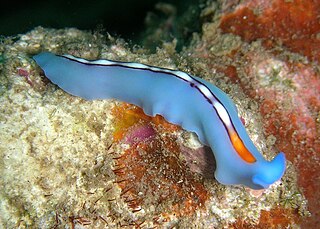
The genus Glycera is a group of polychaetes commonly known as bloodworms. They are typically found on the bottom of shallow marine waters, and some species can grow up to 35 cm (14 in) in length.

Nereis is a genus of polychaete worms in the family Nereididae. It comprises many species, most of which are marine. Nereis possess setae and parapodia for locomotion and gas exchange. They may have two types of setae, which are found on the parapodia. Acicular setae provide support. Locomotor setae are for crawling, and are the bristles that are visible on the exterior of the Polychaeta. They are cylindrical in shape, found not only in sandy areas, and they are adapted to burrow. They often cling to seagrass (posidonia) or other grass on rocks and sometimes gather in large groups.

Lineus is a genus of nemertine worms, including the bootlace worm, arguably the longest animal alive. Lineus contains the following species:

Pseudoceros is a genus of the flatworms Platyhelminthes.

Pseudobiceros is a genus of flatworms. Like all flatworms, Pseudobiceros are hermaphrodites. This particular genus engages in penis fencing. When the "winner" touches its penis to the "skin" of the other, insemination occurs, and the "loser" has to bear the burden of motherhood.
Cryptocelidae is a family of flatworms.

Phyllodoce is a genus of polychaete worms, which contains about 200 species. The prostomium bears eyes, two pairs of antennae and a pair of large retractile nuchal organs. The eversible proboscis is clearly divided into two parts.

Amphinomidae, also known as the bristle worms or sea mice, are a family of marine polychaetes, many species of which bear chaetae mineralized with carbonate. The best-known amphinomids are the fireworms, which can cause great pain if their toxin-coated chaetae are touched or trodden on. Their relationship to other polychaete groups is somewhat poorly resolved.

Acanthozoon is a genus of polyclad flatworms belonging to the family Pseudocerotidae.

Cirriformia is a genus of marine polychaete worms in the family Cirratulidae.

Notocomplana is a genus of flatworms. It is the only genus in the monotypic family Notocomplanidae.

Bispira is a genus of marine bristleworm in the family Sabellidae. Its members were initially included in genus Sabella by Grube in 1851. In 1856, Krøyer described Bispira as a separate genus. Members of Bispira are defined by spirally-coiled, equally-divided branchial lobes.
Thysanozoon flavotuberculatum is a species of flatworm of the genus Thysanozoon, that was first described in 1939. T. flavotuberculatum is greyish with scattered black flecks and yellow papillae. It is found in the seas around Australia and Indonesia.

Lepidonotus is a genus of marine annelids in the family Polynoidae. The genus occurs globally and includes 80 species, usually found in shallow waters down to about 80 metres.
Sigalionidae is a family of polychaetes belonging to the order Phyllodocida.
Vermiliopsis is a genus of polychaetes belonging to the family Serpulidae.

Cerebratulus is a genus of nemerteans belonging to the family Lineidae.

Eurythoe is a genus of polychaetes belonging to the family Amphinomidae.
Lumbrineris is a genus of polychaetes belonging to the family Lumbrineridae.














